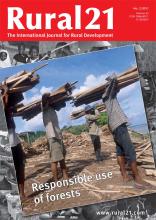Land Library
Welcome to the Land Portal Library. Explore our vast collection of open-access resources (over 74,000) including reports, journal articles, research papers, peer-reviewed publications, legal documents, videos and much more.
/ library resources
Showing items 37 through 45 of 100.Against the backdrop of increasing deforestation in Natural Protected Areas due to illegal logging and shifting agriculture, the Peruvian association DRIS has implemented a programme in three districts of the country.
The number of woodfuel consumers in Africa is projected to increase from around 2.5 billion in 2004 to 2.7 billion by 2030, with sub-Saharan Africa accounting for the highest increase.
Zambia’s small-scale farmers are even poorer today than they were 40 years ago. According to the 2010 Human Development Report, Zambia is one of just three nations whose development has fallen behind 1970 levels.
Migration is a huge phenomenon. The share of migrants in industrial countries’ populations doubled over the past three decades, and remittances ? ows to developing countries are larger than foreign investment or overseas aid.
The sheer number of refugees from Zimbabwe puts a heavy burden on the province of Limpopo in South Africa. These new arrivals strain the already weak structure of the local labour market. The result is frustration and bitterness for local people.
Surveys over several years in the Kagera region of Tanzania have shown that migration has a positive impact on people's living standards, even for those who remain in agriculture.
In today’s China, about 220 million rural migrant workers are on the move – this is more than two thirds of the US population – and their number is set to increase in the course of the country’s urbanisation process.
Climate change is one of the major threats to the development of rural Africa, and without wide-ranging adaptation strategies the challenge it presents cannot be met. Although appropriate measures have been identi?
As part of its commitment to local community development in Mozambique, the Community Land initiative (iTC), a project financed by a group of European donors, is supporting part of a honey production chain in Mozambique, specifically in Sussundenga district, Manica province.


